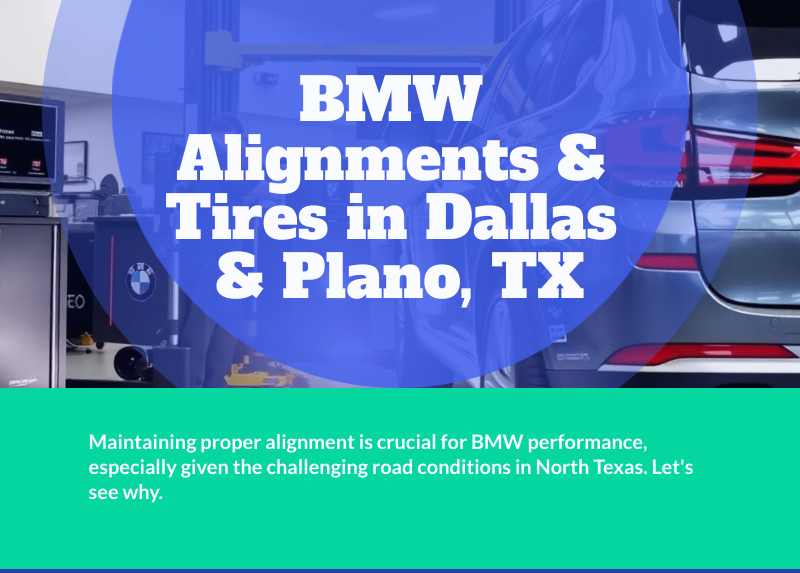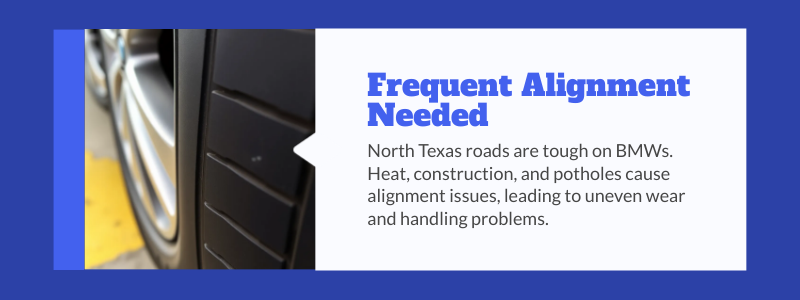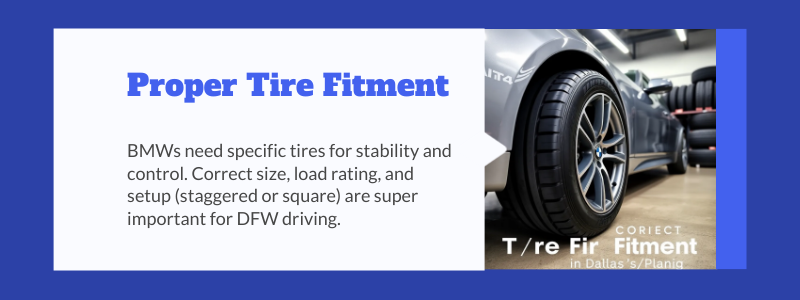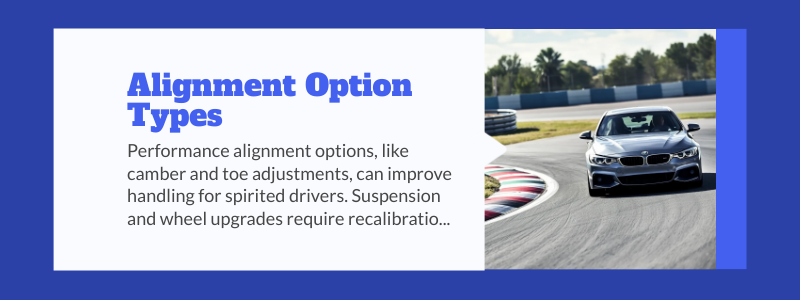
Precision Handling, Tire Longevity, and Chassis Stability for North Texas Roads
BMW Performance Depends on Proper Alignment and Tire Quality
BMW engineering is centered around balance, precision, and dynamic stability. Every model—from the 3 Series and 5 Series to the X5, X7, and M variants—relies on exact suspension geometry and high-quality tires to maintain the brand’s signature driving feel. When alignment angles drift, or when tires lose integrity, everything from steering accuracy to safety and braking responsiveness begins to decline.
Drivers in Dallas, Plano, Frisco, Richardson, and Addison experience conditions that accelerate wear on BMW suspension and tires more quickly than in other regions. Between extreme heat, rough pavement, frequent construction zones, and sudden pothole impacts, alignment checks and tire inspections are essential to preserving BMW performance.
A BMW aligned to factory (or BMW-specialist) specifications delivers predictable cornering, balanced tire wear, and the precise steering response the vehicle was designed for. When paired with the correct tire selection and professional installation, the car behaves exactly as intended—stable, responsive, and safe.
Why North Texas BMW Drivers Need Alignment Service More Frequently
Unlike cities with smoother infrastructure and mild temperatures, the Dallas–Fort Worth area presents several challenges:
1. Heat-Related Pavement Expansion
Texas summers routinely push road temperatures past safe thresholds for rubber and suspension bushings. Expanded pavement creates sharper seams and harder impacts, which can knock alignment out of tolerance.
2. Persistent Construction Zones
Highway projects on U.S. 75, I-35, George Bush, and the Dallas North Tollway expose drivers to uneven surfaces, steel plates, drop-offs, and debris.
3. Potholes and Edge Cracks
Sudden impacts are the leading cause of BMW toe and camber deviations. Even minor potholes can produce subtle misalignment that gradually manifests as uneven inner-edge wear.
4. High-Speed Corridor Driving
Regular driving at 70–85 mph amplifies even minor alignment imperfections. Small deviations become major wear issues at highway speeds common in Dallas and Plano.
Because of these factors, many BMW specialists in North Texas recommend alignment inspections more often than the nationwide average.
How BMW Alignment Works — and Why Precision Matters
A proper BMW alignment focuses on three major angles, each of which plays a role in vehicle behavior:
Toe
Toe refers to whether the tires point inward or outward. Mis-toe causes rapid tire wear, vague steering feel, and increased drag.
Camber
Camber determines how much the tire leans in or out. BMW models often run slight negative camber for handling stability. Excess negative camber, however, causes aggressive inner-edge wear—common on Dallas/Plano BMWs.
Caster
Caster affects steering stability and straight-line behavior. When caster is off, the BMW may wander, pull, or feel unstable at highway speeds.
Thrust Angle
Vital on rear-wheel-drive and xDrive models, thrust angle determines whether the rear tires track straight. When off, the vehicle may feel unsettled even if the steering wheel seems centered.
Why BMW Needs More Exact Calibration
BMW suspension systems are more sensitive than many brands because:
- They are designed with performance geometry.
- Many models use multi-link rear setups with complex adjustments.
- Some alignments require proper vehicle weighting during calibration.
- Steering angle sensors require reset after certain adjustments.
Generic “toe-only” alignments do not protect BMW handling characteristics or tire life. Only a full multi-angle, BMW-calibrated alignment ensures the vehicle behaves as engineered.
Signs Your BMW Needs Alignment in Dallas or Plano
Drivers should schedule alignment service when experiencing any of the following:
- Inner-edge tire wear (especially common on BMW rear tires).
- Pulling or wandering when driving straight.
- Steering wheel off-center during normal travel.
- Vibrations or shimmy between 50–85 mph.
- Squealing tires during low-speed turns.
- Uneven ride height or suspension imbalance.
- Reduced steering sharpness or delayed response.
These symptoms often worsen quickly in North Texas due to the road conditions described earlier. Addressing alignment early prevents further wear on tires, bushings, control arms, and tie rods.
BMW Tires in Dallas and Plano: Why Proper Fitment Is Critical
BMW vehicles are engineered with specific tire requirements. Proper tire selection ensures stability, traction, and dynamic control, especially in the challenging driving environments around DFW.
Correct Tire Size and Load Rating
BMW’s performance characteristics depend on matching the manufacturer’s recommended tire width, sidewall height, and speed/load rating. Incorrect sizing affects handling balance and can confuse stability controls.
Staggered vs. Square Setups
Many BMWs are equipped with staggered setups (wider rear tires). These cannot be rotated conventionally, making alignment accuracy essential. A single misaligned wheel on a staggered setup wears rapidly and can require premature tire replacement.
Run-Flat vs. Non-Run-Flat Tires
BMW offers both:
- Run-flat tires preserve mobility during punctures but can feel harsher over rough Dallas roads.
- Non-run-flat tires deliver a smoother ride and better grip but require readiness for emergency situations.
Heat-Resistant Compounds
Dallas heat breaks down softer compounds faster. The wrong tire selection leads to early wear, cracking, or tread hardening.
Wheel Damage from North Texas Roads
Pavement irregularities frequently cause:
- Bent wheels
- Sidewall bubbles
- Internal belt separation
These issues can mimic alignment problems but require separate diagnosis.
BMW Tire Replacement: What Dallas and Plano Owners Should Expect
BMW tire service should always include the following steps:
1. Inspection for Wear Patterns
A technician checks tread depth, inner/outer shoulders, cupping, and feathering. BMWs frequently show uneven inner shoulder wear when alignment drifts.
2. High-Precision Balancing
High-speed travel on Dallas highways demands precise balancing to eliminate vibrations.
3. Wheel Inspection
Bent wheels are extremely common locally and must be addressed before alignment for accurate results.
4. Correct Torque Specifications
BMW wheel bolts require specific torque to prevent rotor warping and ensure proper seating.
5. Tire Pressure Calibration
Weather swings in the metroplex cause rapid pressure fluctuations. Proper PSI is essential for BMW driving dynamics.
6. DSC and TPMS System Verification
After tire service, BMW stability and pressure monitoring systems should be checked for correct operation.
Why Alignment and Tire Service Should Be Paired
A new set of tires installed without correcting alignment will not last — especially on BMW models with sharp suspension geometry. Likewise, an alignment performed on worn or unevenly damaged tires cannot be accurate.
Pairing the two ensures:
- Maximum tire lifespan
- Even tread contact
- Predictable handling
- Balanced cornering behavior
- Better braking response
- Safe wet-road traction
With Dallas/Plano road conditions, combining alignment and tire service dramatically improves long-term performance.
BMW Performance Alignment Options
Drivers who enjoy spirited driving or have performance-oriented models may benefit from alternative alignment specifications.
Performance-Oriented Camber Adjustments
Modest increases in negative camber improve cornering grip without compromising daily drivability.
Toe Adjustments for Sharper Steering
Performance toe settings can enhance turn-in feel, particularly on M Sport or M Performance models.
Suspension Modifications
Lowering springs, coilovers, or upgraded control arms require a fresh alignment using custom specifications.
Wheel and Tire Upgrades
Larger wheels or wider tires change suspension geometry and require recalibration.
A specialist determines whether factory specs or performance variants offer the best balance for the driver’s needs.
How BMW Alignment Affects Safety
Proper alignment is essential to safety systems including:
- ABS
- DSC (Dynamic Stability Control)
- Lane-keeping systems
- Steering angle sensors
- Traction control
Misalignment changes the way sensors interpret movement. In emergency conditions, even slight deviations reduce system effectiveness.
Protecting Tire Life on Dallas and Plano Roads
BMW owners can extend tire life significantly with consistent maintenance:
- Check tire pressure monthly (heat causes rapid fluctuations).
- Schedule alignment every 6–12 months depending on driving style.
- Rotate tires when equipment allows (square setups only).
- Replace worn bushings or control arms promptly.
- Avoid aggressive cornering on worn tires.
- Inspect wheels for bends after hard impacts.
Driving habits also influence longevity. Smooth acceleration, braking, and turning prolong both tires and suspension components.
When BMWs Need Immediate Alignment or Tire Attention
Certain conditions require prompt inspection:
- After hitting a pothole, curb, or debris
- When a vibration develops suddenly
- When the steering wheel shifts position
- When the car drifts unexpectedly
- When tires wear rapidly on one side
- After suspension or steering component replacement
- After wheel repair or wheel replacement
Ignoring these conditions leads to escalating repair costs, including early tire replacement, premature suspension wear, and compromised handling.
How Local Driving Environments Influence BMW Suspension Wear
BMW suspension components are engineered for precision, but their lifespan is heavily influenced by real-world driving environments. In Dallas and Plano, the combined effects of heat, speed, and road texture accelerate wear on control arm bushings, ball joints, sway bar links, and tie rod ends. When these parts begin to age, alignment angles shift gradually, and the BMW develops subtle symptoms long before they become noticeable to the driver.
Suspension wear becomes more pronounced in vehicles frequently driven on the Dallas North Tollway or I-635, where higher speeds magnify every small impact. Light trucks and commercial vehicles in the Metroplex add to the surface imperfections, creating divots and ruts that directly affect wheel alignment. Because BMW suspension tolerances are more exact than those of typical commuter vehicles, they reveal wear sooner through uneven tire wear, mild vibration, or excessive steering correction. Identifying and correcting these early signs protects the chassis and helps maintain the crisp handling BMW models are known for.
Why BMW Wheel Balance Is Just as Important as Alignment
Wheel balancing and alignment are separate procedures, yet both influence how smoothly a BMW tracks at speed. Unbalanced wheels create high-frequency vibrations that spread through the steering wheel or chassis, especially noticeable between 55–75 mph on Dallas highways. These vibrations not only reduce driving comfort but can also cause the tires to wear unevenly, even when alignment angles are technically correct.
In the Dallas/Plano area, balancing issues are more common due to frequent temperature swings and the density of construction zones, which increase the likelihood of wheel damage. A wheel that’s even slightly bent will never balance correctly, and the issue worsens at higher speeds. Ensuring both precise alignment and accurate wheel balance allows the BMW to maintain stability, reduce driver fatigue, and achieve maximum traction on both dry and wet North Texas roads.
The Connection Between BMW xDrive Systems and Proper Tire Matching
BMW’s xDrive all-wheel-drive system relies on consistent tire rolling diameters to distribute torque correctly. When one or more tires differ significantly in tread depth or internal structure, the xDrive system compensates by modulating torque, which can lead to drivetrain strain over time. This problem is more common than many drivers realize, especially when replacing tires individually or mixing brands.
Because Dallas and Plano drivers often experience uneven inner-edge wear on BMW rear tires, mismatched tread depths can develop far earlier than expected. If the front and rear rolling diameters differ too much, the vehicle may exhibit subtle binding in tight turns, minor surging during acceleration, or premature wear on differential components. BMW technicians in North Texas regularly check tread depth consistency during tire service to ensure the xDrive system functions correctly and remains protected under local driving conditions.
How Regular Alignment Protects More Than Tires
Tire life is the most visible consequence of alignment issues, but several other components are affected. When toe, camber, or caster deviate from specification, the vehicle’s suspension works harder to maintain stability. Control arm bushings flex beyond their designed range, tie rods operate at unnatural angles, and wheel bearings may experience uneven loading. Over time, this accelerates wear and contributes to ride quality degradation.
In Dallas and Plano, where many BMWs see long daily commutes and routine highway travel, the added stress becomes more noticeable. Vehicles maintained with consistent alignment service experience fewer suspension failures and maintain a smoother, more controlled ride over the lifespan of the car. This proactive approach reduces long-term repair costs and preserves the factory feel of the vehicle.
Why BMW Drivers Should Inspect Tire Pressure More Frequently in North Texas
Tire pressure fluctuates more dramatically in regions with sharp temperature changes. North Texas routinely experiences large temperature swings within a single week, especially during seasonal transitions. Under-inflated tires increase rolling resistance, compromise fuel efficiency, and make the tires more vulnerable to shoulder wear. Over-inflation hardens the contact patch and reduces grip, leading to traction inconsistencies during aggressive driving or sudden braking.
BMW tire pressure monitoring systems provide good guidance, but they cannot detect developing issues as precisely as a manual check. For Dallas and Plano BMW owners, checking tire pressure monthly—or before long interstate trips—helps maintain alignment accuracy and ensures even tire wear across the vehicle.






